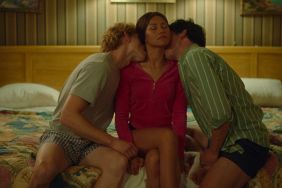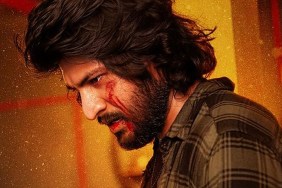

His latest, with the appropriately absurd title A Pigeon Sat on a Branch Reflecting on Existence, completes the trilogy with his signature style of black comedy, unmoving single takes, actors painted a whiter shade of pale and all the sets meticulously constructed in-studio for maximum effect… even for scenes that take place outdoors. The resulting tableau resembles a series of 39 single-panel cartoons come to life in a dreamlike way that’s so far from a standard cinematic experience, yet as engaging as our own memories.
After four-solid years in production, A Pigeon… won the prestigious Golden Lion at last year’s Venice Film Festival and is presented in America by Andersson superfans Alejandro González Iñárritu (Birdman) and Darren Aronofsky (Noah). We sat down with Roy Andersson in New York for a lively conversation about his influences (Tati, Buñuel), the people he’s influenced (Mike Leigh, The Wachowskis) and which one of the 120 or so segments in his three films he’d like sent into space.
ComingSoon.net: All three films feel like they’re of a piece, but how do you feel you’ve evolved stylistically since “Songs From the Second Floor”?
Roy Andersson: It’s hard for me to say myself. I don’t feel so far from the other movies. The obvious thing is the style has changed a little because we now work with digital techniques, which is a first time for me. I tried it with some commercials, but I’ve found it’s very good and now I’m so happy I’ve changed to digital shooting! It’s fantastic!
CS: You don’t have to wait for it to develop to know it’s a good take…
Andersson: And you have the monitor display at the side of the camera so I can look there instead of at the scenery. That’s better for me. I didn’t believe that could be possible, now I’ve accepted it as the better method than being at the side of the camera.
CS: You also used green screen for the first time on this one.

CS: That’s still a lot!
Andersson: Yeah yeah! And we had to prolong it and change their positions. Now you have the impression that there are hundreds of horses.
CS: Didn’t you also use it in the scene at the train station with the two salesmen?
Andersson: Right. The train stop is by help of green screen and digital technique. You saw that?
CS: Yeah. I can spot that stuff, and it’s also a change from your normal setup where you use perspective models and foreground miniatures, things like that. You still use some of those for this, right?
Andersson: Yeah. I like it! The method is called trompe-l’œil, the French method. You have a set and you want to prolong the height of a ceiling or something else and there is no space to do it, so you can minimize that and put it between the camera and the set to increase space.
CS: Those techniques have a very charming quality.
Andersson: Yes! I prefer that before digital solutions. It’s handmade, and you feel it.
CS: It’s tactile, and it’s part of the awe you can produce with your films knowing that you didn’t go to a location, even if the scene is outdoors. There is something unique and throwback about that. It’s annoying when people compare you to Ingmar Bergman, just because you’re Swedish. To me you’re more akin to Jacques Tati, the way you build the physical environments and the physical comedy.
Andersson: Yes, absolutely. Especially “Playtime.” What I miss with Ingmar Bergman… I think he deserves his reputation, in some sense, but for me he lacks humor. So that’s why I don’t feel so much related to him. He’s always battling with his relation to God. Sometimes I think it’s not very serious, it’s hypocrisy. He’s not really honest about his battle with God, its just good stuff for a movie! (laughs)

Andersson: (laughs) That’s not a very delicate question. Of course, of course, I think of that many times. I don’t want to be cynical and misuse people. I think that I have another ambition than for my own pleasure, it’s about telling how society can be badly developed with a lot of injustice and lack of respect, empathy and so on. I don’t like to call myself an “artist,” I work with artistic tools. If you do that you have some kind of responsibility also, because these things will give the people stuff to build up their worldview. You have to be very careful and very honest also.
CS: Right, one imagines a director often asking themselves, “Is what I’m doing worthy of all these other people’s energy and time?”
Andersson: That’s true. I started to be involved in filmmaking because I saw all these good films. When I saw these good films I thought, “I want to make movies that are as good as ones I’ve seen myself.” That was a period at the end of the fifties, the sixties and the beginning of the seventies. In Europe especially so many good things were made.
CS: It says something that we’re still today looking back at that period. Robert Towne told me once that the reason people look back at that era as a watershed was because that was when the Hays Code loosened up and you could depict sexuality and violence and political ideas more overtly.
Andersson: Even music was more interesting at that time! (laughs) More vital and avant garde.
CS: Speaking of music, where did that song you play at the end, “Shimmy Doll,” come from?
Andersson: You know, that is the end music in “Viridiana,” by Luis Buñuel. Fantastic movie, it’s one of my three favorites in film history. It’s about a nun whose forced to visit her uncle and… it’s a very good movie. You have to see it, it’s an obligation! But yes, it’s an homage to Buñuel, that rockabilly, and it’s also in the middle of the movie at the bar.
CS: So you’re talking about the people that influenced you, but then there’s the people that you’ve influenced. Andy and Lana Wachowski have name-dropped you in interviews as their favorite current filmmaker, and Lana came to visit the set, right?
Andersson: Yes yes, fantastic. Now, after many many years, it’s more natural for me to have these contacts with other filmmakers abroad. I was not comfortable with that earlier, when I was younger, but now I am. I am honored when Alejandro González Iñárritu and Darren Aronofsky presented this movie in America.

Andersson: That’s true, what movies did they make again?
CS: “The Matrix,” “Cloud Atlas,” “Speed Racer”…
Andersson: Of course! “The Matrix,” yes. They passed Stockholm just to shake hands with me! Mike Leigh passed my studio also to say he really liked my movie and so on. Even Iñárritu and Aronofsky.
CS: With the economics of film funding changing so fast is it harder for you to get financing with your one-two punch of dark subject matter and very long, involved productions?
Andersson: (claps hand) It’s much easier now. How this movie is being received in the world will help me get finances for the next one, especially in Sweden. We have state subsidies and this commission who has absolute high respect for what people say abroad, so now I think I will get full finances. Even privately they can invest. I started “Songs From the Second Floor” with money I got from commercials, financed the first fifteen minutes, made that and showed it to investors and they said, “Yes, we will finance it.”
CS: You don’t have to put your own money in anymore, right?
Andersson: Yes, for a long time I’ve actually had to take loans so I have many debts! I think people who make movies themselves can see the qualities in my work better than other people. They understand the level of difficulty and ambition. For people who make movies themselves it’s very good to talk to them.
CS: Since this is the end of your trilogy and it feels like there’s some finality to it, do you see the next film you work on departing at all from what we’ve come to expect from you?
Andersson: I would like to but it’s hard. It has taken so long to develop this style, so if I’m going to change I have to be very sure I have found something much better. Of course I will change a little, but I will never cut to the close-up! (laughs)

Andersson: There’s a scene you mentioned, “It’s not easy to be a human being,” but there’s a scene from “You, the Living” where a man is very lonely, he’s sitting at the opening of a restaurant and he’s so lonely that he tries to get contact with the two guys who are cleaning the tables at closing time, so he says, desperately, “Now I understand that I’ve been greedy all my life, that’s why I’m so unhappy!” (laughs) That sentence I would have on the satellite.
CS: In all your movies the way you paint the walls of your sets is fascinating. The way you put your actors in white make-up it feels like you also put make-up on the set. Could you talk about that process of getting such a specific look to the sets?
Andersson: I have two ambitions with my movies: I want them to be universal, and I also want to be timeless. So what is timelessness? It’s hard to say. For me it’s from the period when I grew up as a teenager. In Sweden we built up a welfare society and the state started to build many many flats for people who had nowhere to live in. That was a very social responsibility at that time. The architecture and colors from that time is my endlessness. It’s beige, grey-ish, a little bleak. Light with not much strength, not much ampere. I work so much physically with my scenes, but on this movie I worked with a young team and they were so talented and I felt like I would just hinder them. They had just left a very good film school for set design, these four students, and they worked through the whole movie for three years. I left everything to them and they did a very good job.
CS: That’s interesting, because aesthetically “A Pigeon…” is very in keeping with the other two films.
Andersson: Yeah. On those I was involved very much myself, I painted, was a carpenter. Everything has a sketch made by me.
CS: Is realism boring to you?
Andersson: Yes. (laughs) I started my career with realism. I appreciate “The Bicycle Thief” by De Sica, it’s a very realistic movie, but in the long run after fifteen years I thought I might stop making movies and find another job. I was so tired of this realism. Suddenly I understood I had to dare to go into what I call “abstractive style” and create scenes inspired by memory. Memory cleans, and even dreams clean.
A Pigeon Sat on a Branch Reflecting on Existence is now playing in New York City, with Magnolia Pictures giving it a staggered release throughout the US in the coming months.
(Photo Credit: Magnolia Pictures/RoyAndersson.com)









